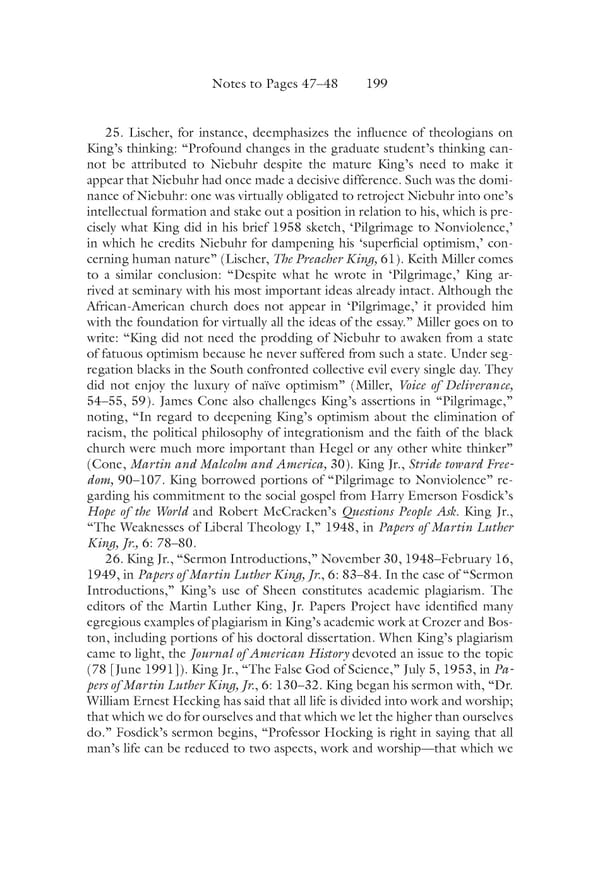Notes to Pages 47–48 199 25. Lischer, for instance, deemphasizes the influence of theologians on King’s thinking: “Profound changes in the graduate student’s thinking can- not be attributed to Niebuhr despite the mature King’s need to make it appear that Niebuhr had once made a decisive difference. Such was the domi- nance of Niebuhr: one was virtually obligated to retroject Niebuhr into one’s intellectual formation and stake out a position in relation to his, which is pre- cisely what King did in his brief 1958 sketch, ‘Pilgrimage to Nonviolence,’ in which he credits Niebuhr for dampening his ‘superficial optimism,’ con- cerning human nature” (Lischer, The Preacher King, 61). Keith Miller comes to a similar conclusion: “Despite what he wrote in ‘Pilgrimage,’ King ar- rived at seminary with his most important ideas already intact. Although the African-American church does not appear in ‘Pilgrimage,’ it provided him with the foundation for virtually all the ideas of the essay.” Miller goes on to write: “King did not need the prodding of Niebuhr to awaken from a state of fatuous optimism because he never suffered from such a state. Under seg- regation blacks in the South confronted collective evil every single day. They did not enjoy the luxury of naïve optimism” (Miller, Voice of Deliverance, 54–55, 59). James Cone also challenges King’s assertions in “Pilgrimage,” noting, “In regard to deepening King’s optimism about the elimination of racism, the political philosophy of integrationism and the faith of the black church were much more important than Hegel or any other white thinker” (Cone, Martin and Malcolm and America, 30). King Jr., Stride toward Free- dom, 90–107. King borrowed portions of “Pilgrimage to Nonviolence” re- garding his commitment to the social gospel from Harry Emerson Fosdick’s Hope of the World and Robert McCracken’s Questions People Ask. King Jr., “The Weaknesses of Liberal Theology I,” 1948, in Papers of Martin Luther King, Jr., 6: 78–80. 26. King Jr., “Sermon Introductions,” November 30, 1948–February 16, 1949, in Papers of Martin Luther King, Jr., 6: 83–84. In the case of “Sermon Introductions,” King’s use of Sheen constitutes academic plagiarism. The editors of the Martin Luther King, Jr. Papers Project have identified many egregious examples of plagiarism in King’s academic work at Crozer and Bos- ton, including portions of his doctoral dissertation. When King’s plagiarism came to light, the Journal of American History devoted an issue to the topic (78 [June 1991]). King Jr., “The False God of Science,” July 5, 1953, in Pa- pers of Martin Luther King, Jr., 6: 130–32. King began his sermon with, “Dr. William Ernest Hecking has said that all life is divided into work and worship; that which we do for ourselves and that which we let the higher than ourselves do.” Fosdick’s sermon begins, “Professor Hocking is right in saying that all man’s life can be reduced to two aspects, work and worship—that which we
 Becoming King: Martin Luther King Jr. Page 219 Page 221
Becoming King: Martin Luther King Jr. Page 219 Page 221